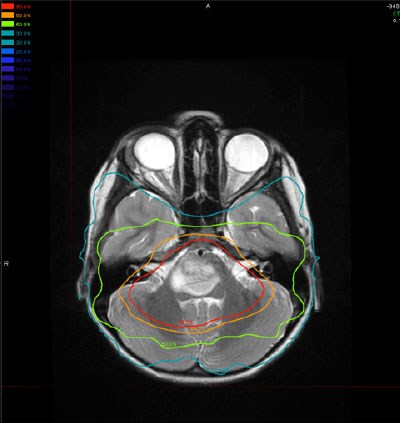Treatment
Specialized pediatric brain tumor centers
DIPGs are relatively rare, and the diagnosis and treatment of DIPG is complex and involves multiple specialists. The experts working with the DIPG Registry recommend that patients and families receive a definitive diagnosis and care at comprehensive, experienced pediatric medical centers with dedicated pediatric neuro-oncologists, neurologists, neuroradiologists, and neurosurgeons. Such centers usually offer multidisciplinary clinics, which allow patients to see multiple specialists during a single visit. This facilitates the close coordination of care. Most specialized pediatric neuro-oncology programs also offer support services such as neuropsychological consultation and school intervention professionals. These centers usually participate in collaborative clinical research groups such as the Children’s Oncology Group or the Pediatric Brain Tumor Consortium, which sponsor clinical trials of experimental treatments.
Sometimes, children with DIPG and their families can travel to a hospital with a specialized brain tumor program for diagnosis and expert advice but receive ongoing care at a hospital closer to home.
Radiation TherapyRadiation therapy (x-rays directed at the tumor) is the only proven beneficial treatment but unfortunately for limited duration. The radiation kills some of the cancer cells, shrinking the tumor and reducing pressure on the brainstem. This can greatly improve how the child feels and functions for a few months, and 75-85% of patients show improvement in symptoms after radiation therapy. Because even carefully aimed radiation therapy causes some damage to the healthy brain tissue surrounding the tumor, there is a limit to how much radiation therapy can be given to each patient. Unfortunately, the cancer almost always grows back after a few months. Proton beam therapy is a specific type of radiation therapy that uses proton particles for treatment rather than the photons (x-rays) that are used for most radiotherapy. Protons have an anti-tumor effect that is very similar to conventional photon radiotherapy. In some brain tumors, protons are superior to proton radiation because they can spare nearby normal brain tissue from potentially harmful effects of radiation. However, they have not been shown to have an advantage in the treatment of DIPG. The image below is a MRI of the brain demonstrating the areas of the brain treated in a typical DIPG patient during radiation therapy. The percentage of the total radiation dose each area receives is encircled. |

|
Radiation Side Effects
Radiation therapy often causes inflammation in the brain, which can temporarily make symptoms worse. Steroids are used to control inflammation when necessary.
In clinical trials, researchers have used drugs called radiosensitizers, which should make cancer cells more likely to die when treated with radiation, to try to make radiation therapy more effective. There have been more than 55 clinical trials over the last 3 decades; none have shown any benefit to patients so far.
Chemotherapy
Current chemotherapy is generally not effective against DIPG. Most cancer-killing drugs are not able to get into the tumor at all, which seems to be protected by the high pressure inside the pons and by the blood-brain barrier, which prevents most drugs given orally or intravenously from reaching the brain.
A series of clinical trials have tested various chemotherapy drugs and combinations of drugs before or along with radiation therapy, but so far, no trial has shown that chemotherapy extends life. Trials of newer molecularly targeted agents and anti-angiogenic agents (drugs that should prevent tumors from forming new blood vessels to feed their growth) have also so far failed to show any significant benefit to patients.
Researchers are studying drugs that may be able to pass through the blood-brain barrier and are also investigating ways to inject chemotherapy drugs directly into the tumor. Work to discover new drugs also continues. As researchers learn more about the causes and biological mechanisms of DIPG, they will be able to design more effective chemotherapies to fight these tumors.
Chemotherapy Side Effects
Some chemotherapy drugs can cause side effects such as diarrhea, constipation, fatigue, and headache. Usually these side effects can be controlled with additional medications.
Surgery
DIPG grows in a way that makes surgical removal (often called “resection”) impossible. The cancer tissue spreads into healthy tissue, and the edges of the tumor are not well defined. Surgeons cannot remove the tumor because there is no way to avoid cutting out healthy brain tissue which is necessary for survival. For information about surgical biopsy, please see the, “Biopsy” section.
